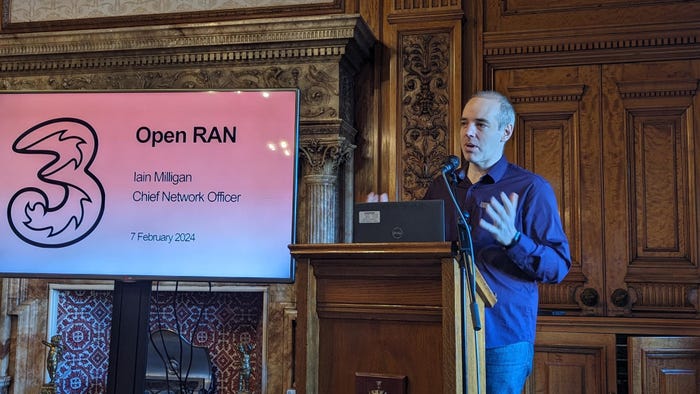Three launches Glasgow urban small cell project with MavenirThree launches Glasgow urban small cell project with Mavenir
UK operator Three is looking to tackle inner-city network congestion with a series of small cell deployments around Glasgow, using Mavenir hardware and software.
February 7, 2024

Three gathered journalists to the Glasgow City Chambers on a brisk February morning to unveil the project, which was described as a trial to improve urban connectivity by deploying a series of small cells on lampposts around the city, as an alternative to new macro sites.
Three UK’s Chief Network Officer, Iain Milligan, gave a presentation in which he pointed out that if you go to one point of Glasgow your 5G reception will be ‘exceptional’ and at another point it will be non-existent.

Small cells are a good solution to this, we were told, because they are relatively cheaper (a small cell costs a 1/9th of the cost of a macro site) and also very targeted at where coverage problem is. It’s not a replacement for macro sites, but an interim solution, apparently.
The first phase is to deploy 20 of the things in centre of city, which should provide an improvement in capacity and coverage footprint, and ultimately 51 are planned.
Later a Councillor came on stage to generally explain how connectivity is beneficial for a modern city’s population, citing autonomous cars and drone deliveries, before touching on the impact of obsolete jobs, new jobs being created, and how Glasgow has ambitions to build ‘the largest IoT innovation hub.’
Describing the project, Milligan told Telecoms.com: “It's part of the government's Open Networks Initiative. We put forward a proposal to challenge every aspect of what the government wanted to achieve… which is Open RAN in a multi-vendor environment in a dense urban area. So we just said Glasgow has the highest variety of multivendor that we have in a small location, dense, urban - let's go for it. So that's what we're going to do, we're going to deploy around 51 small cells in the centre of Glasgow targeted for traffic offload on Open RAN.”
Small cells aren’t new, but Three reckons making them Open RAN is new, suggesting Open RAN deployments from other operators have been all rural, while this project is attempting to make it work in urban environments.
A lot was made of how much of an Open RAN thing this project is, in fact, however Mavenir is providing both the kit and the software for the project.
When asked how this represents a multi-vendor deployment – since if the same thing was being supplied by Nokia it presumably wouldn’t be described as an Open RAN project – Milligan said: “They've [Mavenir] got their own supply chain in terms of a mixture of different hardware components and software aspects. So they've given us a number of options to choose and we select the ones which we think are right for our network. Because it's not just about the radio unit or the equipment, it's what we need within the core as well. So it’s the aspects of how we get integration to there.
“So they’ve been quite good at offering some options and preferences, its not just ‘this is our box, take our box’, its actually ‘what works best for you?’ This product, this solution, this software… and they are then playing the part of developing and tuning the software to make that work together for us. So for me, that's very different than ‘here's our standard list of boxes, it's all one vendor, take that one at that price.’ So it gives us the variability really more than anything else, which determines the price as well.”
So a more flexible set of options seems to be the stated benefit here, which is fine, but some semantical questions could be raised as to what terms like ‘multi-vendor solution’ and ‘Open RAN’ really mean in the contexts of one company providing both the antennas and software.
That aside, if loading a large number of small cells in a city can be proven to improve very patchy 5G signals, and in a way that’s cheaper, easier and quicker than erecting macro sites, the potential value would not be constrained to Glasgow.
About the Author
You May Also Like










.png?width=300&auto=webp&quality=80&disable=upscale)


_1.jpg?width=300&auto=webp&quality=80&disable=upscale)